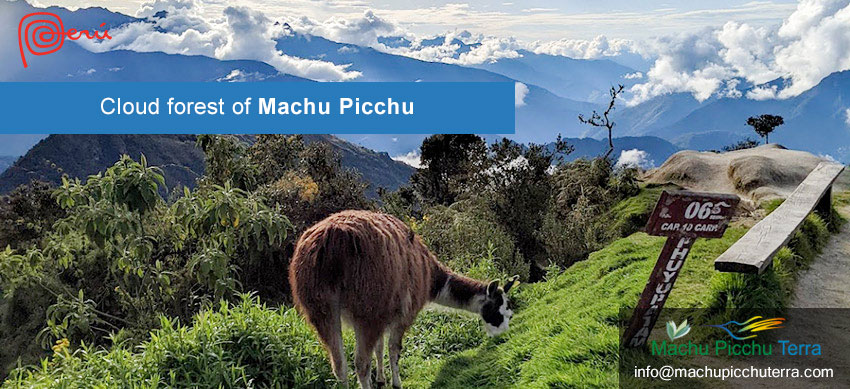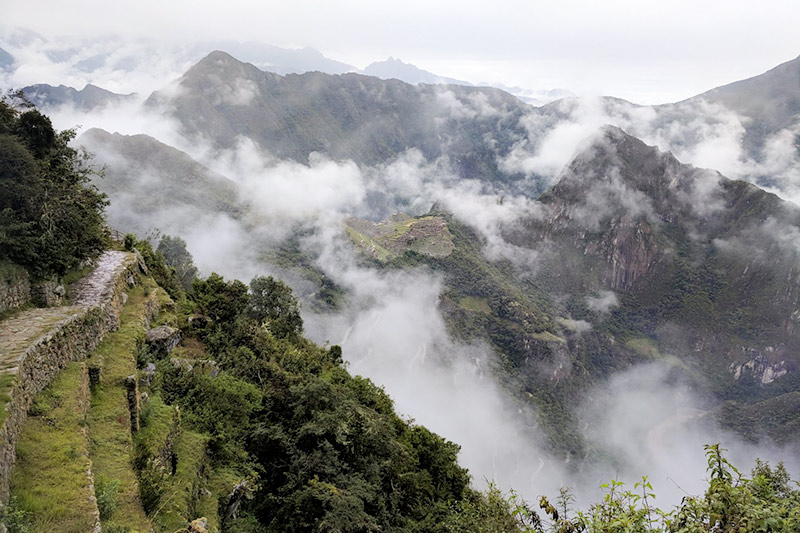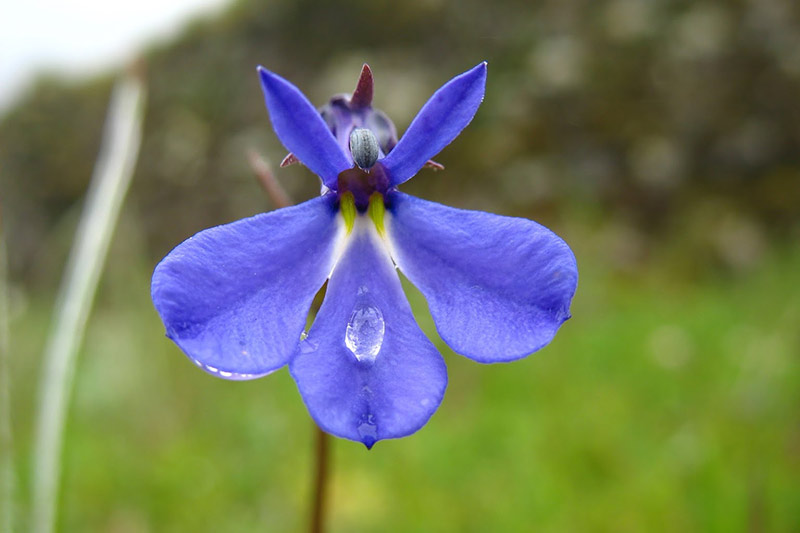
One way to explain and better understand the geography where Machu Picchu is located is to talk about cloud forests. Cloud forests are ecosystems that can be found in many parts of the world. The main characteristics are the high presence of mists and mountain peaks with abundant vegetation. If we see Machu Picchu through photographs we can appreciate all these brief descriptions. However, that is not all, at the time of doing the Inca Trail you can find other landscapes that show spectacular beauty. In this blog, we will learn more about the characteristics of the Cloud Forest of Machu Picchu.
Location of Machu Picchu

One of the viewpoints of Machu Picchu from Huchuy Pichu
Machu Picchu is located in Peru, in the Cusco region, more than 100 kilometers from Cusco. To get to the wonder of the modern world you have to travel by train, sometimes from Cusco and sometimes from Ollantaytambo. There is also the possibility of hiking through different sections. The most popular section to get to Machu Picchu is the Inca Trail, an incredible hiking route that is quite safe and is also an official route provided by the Ministry of Culture of Peru. It is taken care of by this public entity because during the hike you can find several archaeological sites, fauna, flora, and really beautiful landscapes.
If we want to see the political division of Machu Picchu Town, it would belong to Cusco, the province of Urubamba, and the district of Machu Picchu Town. Machu Picchu Town is the place where all visitors, whether nationals or foreigners arrive. Geographically it belongs to the Eastern Cordillera chain and is located at 2430 meters above sea level. It is for this reason that it has a semi-tropical climate, where rain can fall and as mentioned we can find a large presence of fog. For this reason, many anthropologists knew Machu Picchu with the nickname of the City on the Clouds.
Machu Picchu is considered a feat of engineering and architecture. Not only for the location where it is built but also for the particularities of its structures. Especially the important temples that have large stones, perfectly joined and polished with rudimentary equipment. In addition, they have a perfect harmony with the nature of the place. Each construction of Machu Picchu offers truly incredible landscapes thanks to the fact that it was built on the top of a mountain.
Geography in Machu Picchu

One of Machu Picchu’s orchid species
Machu Picchu was built near a mountain where it is estimated that there was a large amount of white to grayish granite. Part of this quarry was used for the construction of the enclosure. Likewise, large geographic faults can be observed in the surrounding mountains. We refer to the mountains of Huayna Picchu and Machu Picchu Mountain. If we talk about Huayna Picchu, the fault is easy to appreciate and has an abysmal fall. At the same time, Machu Picchu Mountain surrounds the archaeological site and the rest of the mountains. Being the highest of all.
The Inca site is located in a strategic place where you can appreciate all the nature that surrounds it. As well as the Huayna Picchu mountain, the one that can be seen in the postcard photos, while the Machu Picchu Mountain, is located in the back covering the entire enclosure with the mountain range. This mountain is the one that connects directly with the Inca Trail route. It is also possible to find in the foothills of the mountain the passing of the Vilcanota River, which is called Urubamba River because of this place.
It can be established that Machu Picchu is built in the region of the Peruvian yungas. This sector is characterized by belonging to the low mountains and the warmth of the Eastern Cordillera. Although it is sparsely populated, the whole region is ideal for growing fruit. That is why other districts dare to export avocados, mangos, tangerines, passion fruit, and other fruits. Some of these can be seen during the Salkantay Trek.
The cloud forest of Machu Picchu
In Machu Picchu, you can find part of the cloud forest geography, especially in the Inca citadel and all around it. One way to check this is during the early morning hours. That is why many tourists are surprised not to have the view that is sold in the postcard photos. The fog also begins to have a greater presence in the rainy season. The Andes of Cusco receive the most rain during December through March. Of course, this can vary by a few days of higher intensity or less regular rainfall.
In areas with more trees, the phenomenon and the formation of cloud forests can be better appreciated. These are usually formed because the water vapor coming from more humid places such as the Amazon moves towards the Andes. Sometimes it overtakes them, but other times it manages to advance. When they come into contact with a colder climate, typical of the Andean heights, they cool down. After that, they take the form of clouds and dense fogs that cover for several hours the top of the mountains of the high jungle.
Normally cloud forests can be found at altitudes ranging from 900 to 2400 meters above sea level. This altitude allows the humidity to be transformed into mist and not necessarily into rain, but we must emphasize that the process, in both cases, is very similar. In the case of Machu Picchu, we can call it the Andean Cloud Forest, due to its close relationship with the Andean mountain range. All this geography makes possible a great variety of species between flora and fauna, as we will see below.
In the entire protected area of the Machu Picchu Historic Sanctuary, great Andean and Amazonian biodiversity can be conserved. For example, there are 384 species of trees, 468 orchids, 279 ferns, 84 species of mammals, 443 birds, 17 amphibians, and 22 reptiles.
Characteristics of the Machu Picchu cloud forest

View of the mountains with orange clouds
Cloud forests expand along the eastern slopes of the Andes, as mentioned above. It is also possible to find similar climates in other parts of the world. The main characteristic of the cloud forests both in Machu Picchu and in other parts of the world is that they can shelter a great amount of flora and fauna. Among these species are birds and multicolored plants, this biodiversity allows us to appreciate different living beings where their vivid colors predominate.
In Peru, for example, more than 300 species of birds can be found. Of course, all of them are of different sizes, characteristics, and colors. Unfortunately, 23 of them are in danger of extinction due to climate change, deforestation, and other similar factors. Luckily they are promoting protected areas around Machu Picchu. Therefore, many times new species, especially mammals, can be seen arriving in the protected area. This sighting could be seen thanks to the camera traps that are used to control the place.
In Machu Picchu, you can find a large number of orchids, another species that can grow more easily thanks to the humidity of the place. Likewise, in the surroundings of Machu Picchu, more than 420 species of orchids could be registered. Most of these plants, along with some other species such as birds, are cared for by SERNARP. This institution is in charge of registering in detail the species of flora and fauna that can be found in the Machu Picchu Natural Sanctuary.
It is important to promote the care of the entire geographical sector that is understood as the cloud forests both in Machu Picchu and the rest of the world. This is not only because of the number of species in its territories and extensive geography but also because it allows us to know the changes that the planet is undergoing. These changes can be easily identified in the cloud forests because the biodiversity in these places usually has endemic characteristics, so the drastic changes in the region will be reflected in the population of the species of the place, hence the special care of the environment and this sector adjacent to Machu Picchu.
Inca Trail 4 Days: Ideal Cloud Forest Route
Those who wish to have a 4-day adventure through the cloud forests and even, why not, understand in a better way all this geography. You can do it by walking the Inca Trail. This route will start in Piscacucho, a community, where you will arrive thanks to the trains. From this point, the trek will begin. The first two days will be made by a geography very similar to that of Cusco, but in the distance, you can already see a lot of vegetation in the mountains. But in the first mountains, which is where the trek begins, you will find little vegetation.
These first days you will have to follow ascending routes that will allow you to appreciate beautiful landscapes. During the third day, the characteristics of the cloud forest can be better appreciated. It is important to emphasize that during this trekking route the activities will start early, from 5:00 in the morning at best. So from the third day and reaching the fourth it is likely that we will have the view of these famous misty clouds that keep in their density a large amount of vegetation and fauna. As we saw above. Probably you will not see all the species, because for that you would have to explore inside the virgin forest.
However, it is possible to find some species of birds, plants, and insects, without the need to leave the route traced by the urban planners of Tawantinsuyo. In this way, the safety of tourists and the care of the environment is guaranteed. A factor that encourages more people to do the Inca Trail, is that many people have seen the presence of the cock of the rock, lots of orchids, and other birds during their walk to Machu Picchu. For all these reasons, try to make a conscious trip without having a strong environmental impact on the environment.
By Inca Trail Machu Picchu - Last updated, 28-02-2024
Interested in the Inca Trail? Know more about Nature!
- Coca leaf, ideal for trekking in Peru
- The Cantuta flower. Where to find it on the Inca Trail?
- Fauna of the Inca Trail
- Spectacled bear on the Inca Trail to Machu Picchu
- The cock of the rocks on the Inca Trail
- Inca Trail: butterfly observatory
